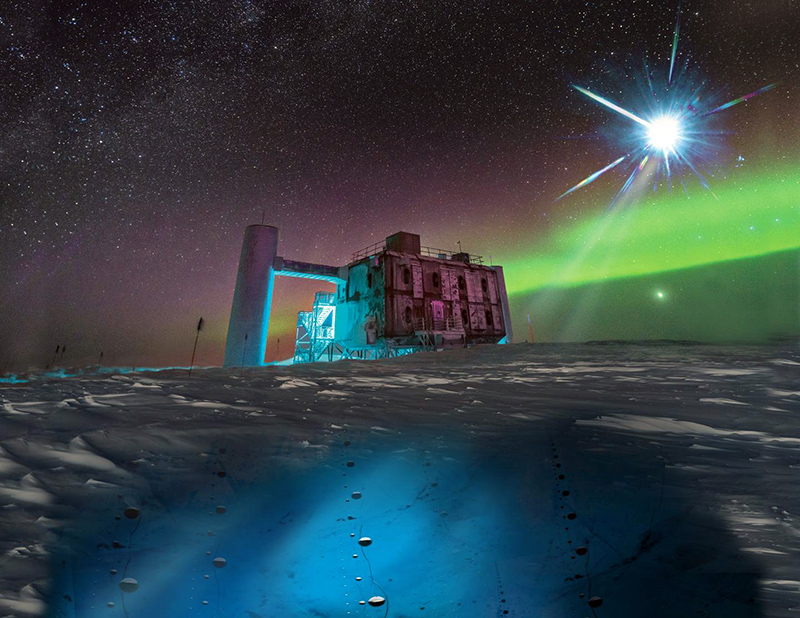
An international team of scientists, with key contributions from researchers at the University of Maryland, has found the first evidence of a source of high-energy cosmic neutrinos, ghostly subatomic particles that travel to Earth unhindered for billions of light years from the most extreme environments in the universe.
The observations, initially made by the IceCube Neutrino Observatory at the Amundsen-Scott South Pole Station and confirmed by ground- and space-based telescopes around the globe, help resolve a century-old riddle about what sends subatomic particles such as neutrinos and protons speeding through the universe. The coordinated effort relied on an alert system that UMD researchers played a lead role in developing.
Two papers published July 13 in Science provide evidence that energetic particles may originate in jets spewing forth from supermassive black holes-astrophysical objects dubbed blazars because of the blazingly bright light they emit toward Earth. One blazar, designated TXS 0506+056 by astronomers, was singled out as a possible source following an automated alert sent around the world by IceCube on Sept. 22, 2017.
Equipped with a nearly real-time alert system-developed in part by researchers at UMD and triggered by a single very high-energy neutrino colliding with an atomic nucleus in the Antarctic ice in or near IceCube's detectors-the IceCube experiment broadcast the coordinates from which the Sept. 22 neutrino likely came. Two gamma-ray observatories, NASA's orbiting Fermi Gamma-ray Space Telescope and the Major Atmospheric Gamma Imaging Cherenkov Telescope, or MAGIC, in the Canary Islands, detected a flare of high-energy gamma rays that also appeared to come from TXS 0506+056, a convergence of observations that convincingly implicated the blazar as the most likely source.
A blazar is an active galactic nucleus with a relativistic jet (a jet traveling at nearly the speed of light), in which the jet is directed very nearly toward the Earth. Relativistic beaming of electromagnetic radiation from the jet makes blazars appear much brighter than they would be if the jet were pointed in a direction away from the Earth. Blazars are powerful sources of emission across the electromagnetic spectrum and are observed to be sources of high-energy gamma ray photons. Blazars are highly variable sources, often undergoing rapid and dramatic fluctuations in brightness on short timescales (hours to days). Some blazar jets exhibit apparent superluminal motion, another consequence of material in the jet traveling toward the observer at nearly the speed of light.
Fermi was the first telescope to identify enhanced gamma-ray activity from TXS 0506+056 within 0.06 degrees of the IceCube neutrino direction. In a decade of Fermi observations of this source, this was the strongest flare in gamma rays, the highest-energy photons. A later follow-up by MAGIC detected gamma rays of even higher energies, and observations from other instruments-including optical, radio, and X-ray telescopes-bolstered the case for TXS 0506+056 as the source of the Sept. 22 high-energy cosmic neutrinos.
Since they were first detected more than a hundred years ago, cosmic rays-highly energetic particles that continuously rain down on Earth from space-have posed enduring questions: What creates and launches these particles across such vast distances? Where do they come from?
Because cosmic rays are charged particles, their paths are bent by the magnetic fields that fill space. But the powerful cosmic accelerators that produce them also produce neutrinos, which are uncharged and thus unaffected by even the most powerful magnetic fields. Because they rarely interact with matter and have almost no mass, neutrinos travel nearly undisturbed from their creation, giving scientists an almost direct pointer to their source.
A neutrino is a fermion (an elementary particle with half-integer spin) that interacts only via the weak subatomic force and gravity. The mass of the neutrino is much smaller than that of the other known elementary particles. Although only differences of squares of the three mass values are known as of 2016, cosmological observations imply that the sum of the three masses must be less than one millionth that of the electron. The neutrino is so named because it is electrically neutral and because its rest mass is so small (-ino) that it was long thought to be zero. The weak force has a very short range, gravity is extremely weak on the subatomic scale, and neutrinos, as leptons, do not participate in the strong interaction. Thus, neutrinos typically pass through normal matter unimpeded and undetected.
Detecting high-energy cosmic neutrinos requires a massive particle detector, and IceCube is by volume the world's largest. Encompassing a cubic kilometer of deep, pristine ice a mile beneath the surface at the South Pole, the detector is composed of more than 5,000 light sensors arranged in a grid. When a neutrino interacts with the nucleus of an atom, it creates a secondary charged particle, which, in turn, produces a characteristic cone of blue light that is detected by IceCube and mapped through the detector's grid of sensitive cameras. Because a charged particle and the light it creates stay essentially true to the neutrino's direction, they give scientists a path to follow back to the source.
Particles of particular interest to the IceCube team pack a more energetic punch. The neutrino that alerted telescopes around the world had an energy of approximately 300 TeV. (The energy of the protons circulating in the 26.7-kilometer ring of the Large Hadron Collider is 6.5 TeV.)
Following the September 22 detection, the IceCube team quickly scoured the detector's archival data and discovered a flare of over a dozen astrophysical neutrinos detected in late 2014 and early 2015, coincident with the same blazar, TXS 0506+056. This independent observation greatly strengthens the initial detection of a single high-energy neutrino and adds to a growing body of data that indicates TXS 0506+056 is the first known accelerator of the highest energy neutrinos and cosmic rays.